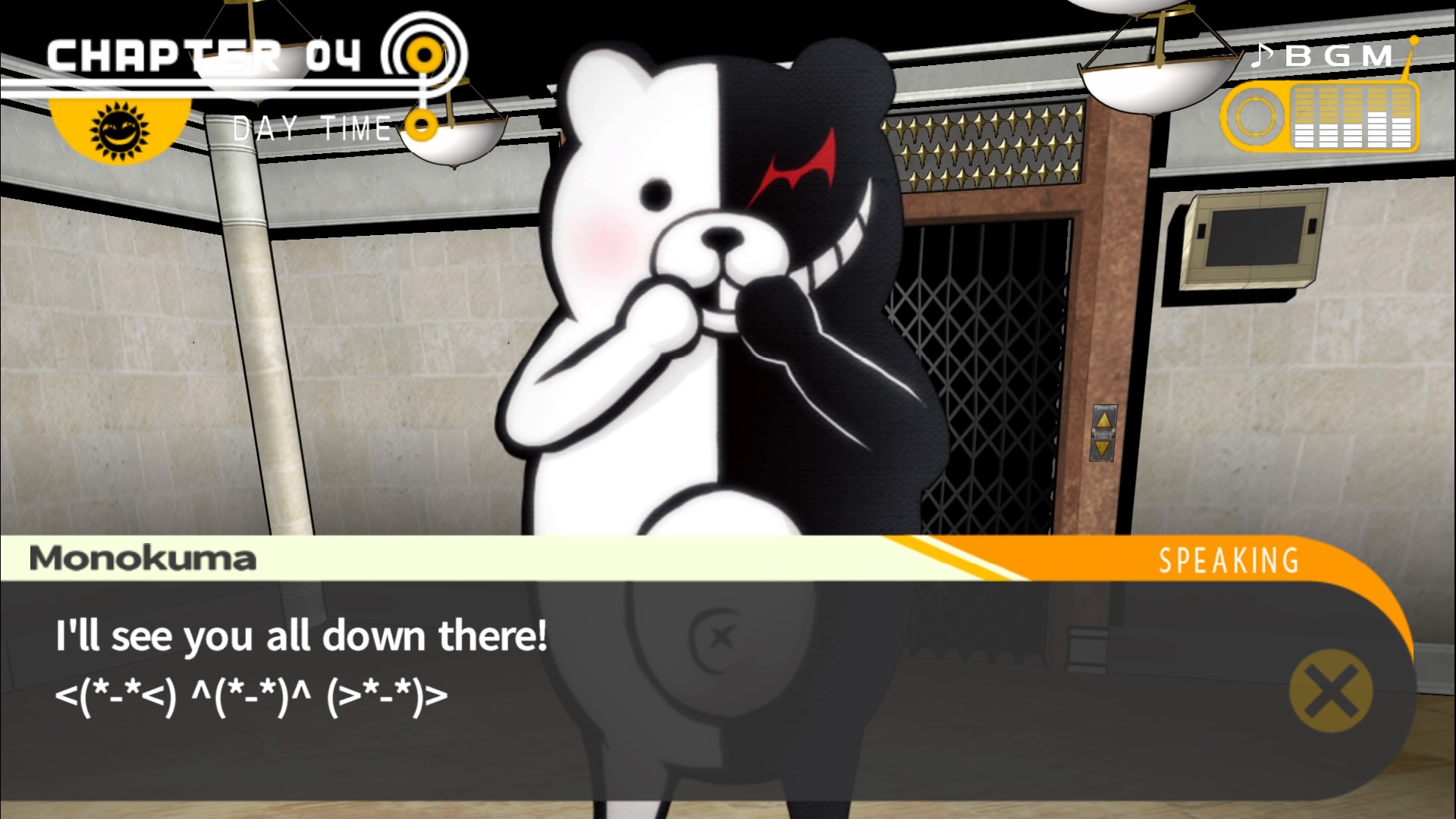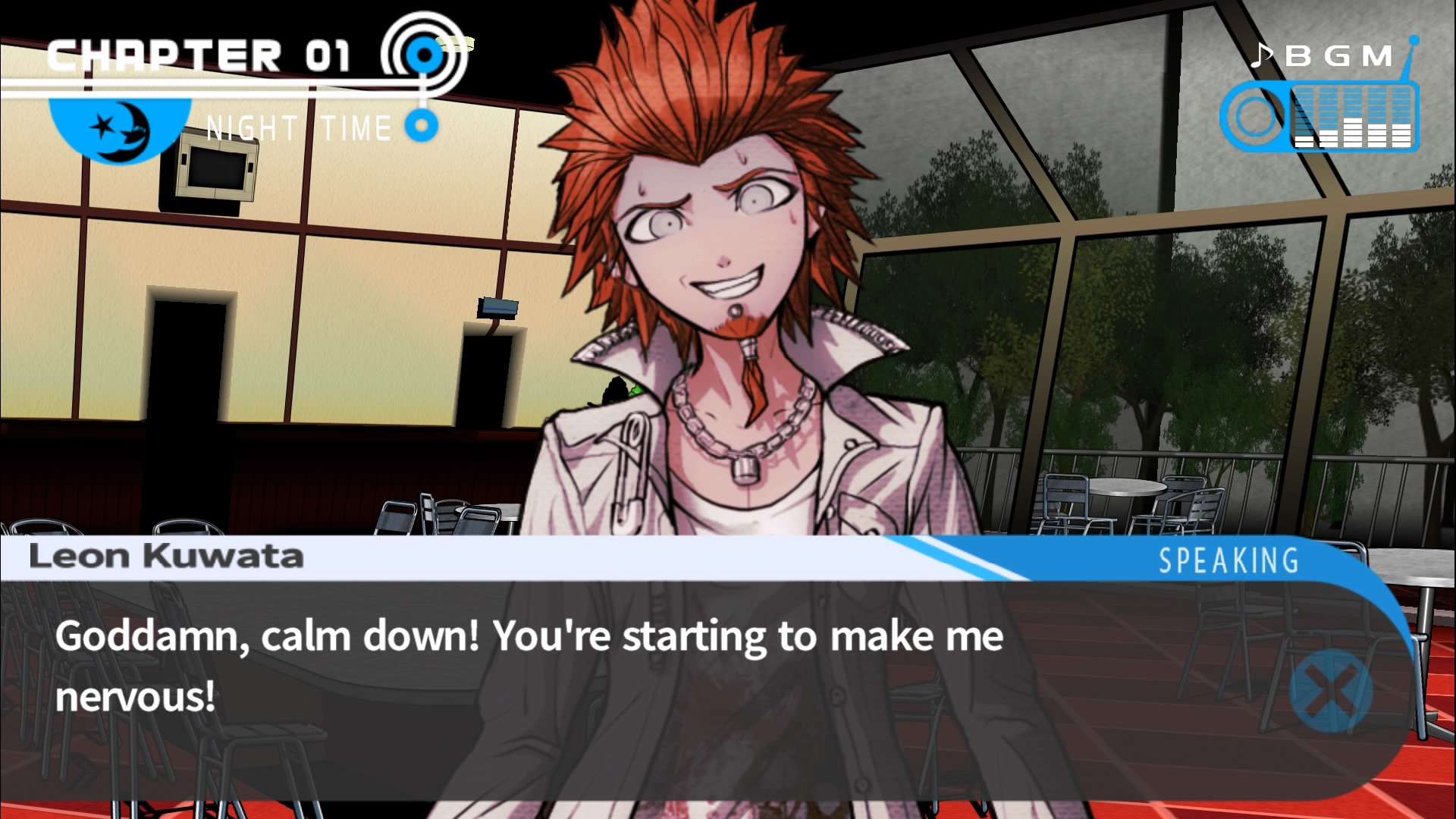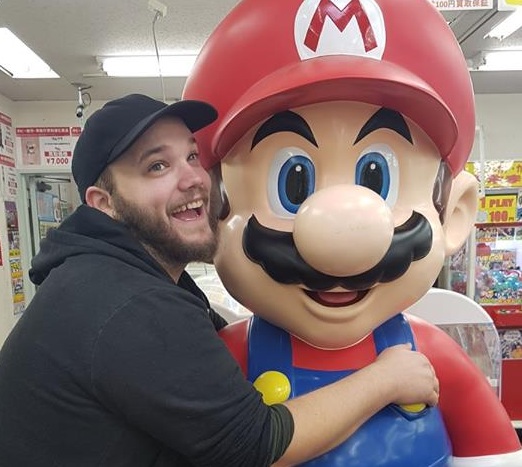
I just want to start by saying that, collectively, it took me about 60 odd hours to finish both of these games, and that’s time I’m never getting back. On the one hand, I really want to like these games because, honestly, the overall story isn’t half bad. On the other hand, sweet Christmas do the Danganronpa games have a lot of problems. Drowning in what I would consider being the worst anime stereotypes around, poor design, and a total inability to just get to the freaking point, there’s just a lot holding these games back. That said, as a collection, Danganronpa 1.2 Reload is probably the best way to play them, if you’re interested. It’s easy to switch between the two games, includes all the content from the Western releases, and both have improved graphics from their handheld counterparts. That’s really all that can be said for the collection itself, so let’s take a look at what each game is like.

Puhuhuhuhuhuhuhuhuhu.
In Danganronpa, players take the role of Makoto Naegi, an utterly average student that’s been selected by lottery to attend a school that only takes in the absolute elite. However, upon arrival you’re knocked out, only to wake up with fourteen other students – all experts in their fields – and discover that you’re all trapped in the school. Monokuma, the perverted, sadistic bear that serves as the school’s “headmaster,” informs you all that you’re now locked into a drawn out death match with one another. If one student can kill another and get away with it, they’ll “graduate” (i.e. escape the school), and the rest will be “punished” (i.e. executed brutally.) The reverse is true if the killer is found out, and thus the game is afoot.
That up there sounds like a cool concept, and it’s certainly what drew me toward the games in the first place. I’ll put it out there right now that I’m not at all a fan of the visual novel/dating sim genres. I’ve played them before and have an idea of what they’re supposed to play like, but they’re not something I would go out of my way to play. In the sense of its genre, however, Danganronpa is an eclectic mix of things. It incorporates aspects of visual novels, dating sims, point ‘n’ click adventures, detective games a la Phoenix Wright (sometimes very specifically Phoenix Wright), and a whole lot of anime. In the end, it’s this huge variance that serves as the game’s strongest and weakest attributes.

Yeah, there’s a lot of this.
When the story actually progresses, and something interesting actually happens, it can be a really intriguing experience. It’s certainly not the deepest of storylines but the ever-present atmosphere that someone is going to murder someone, and the ensuing “whodunnit” phase of the game, made me want to keep going. The problem is everything in between these parts. There’s a lost of drawn out melodrama, repetitive dialogue, and what I can only describe as a kaleidoscope of the very worst anime tropes. Also, a lot of creepy, excessive, needless sexualisation of what are meant to be high school students felt awkward whenever it cropped up, which was often. This isn’t to say that it was entirely bad since there were definitely moments that I couldn’t help but laugh, just that those moments were few and far between.
Getting to know the characters can be interesting but you’re never sure whether or not they’ll be the ones to die next, and as exciting as that might sound, it was endlessly frustrating for me. It meant that whenever someone did die, I usually didn’t care because I just didn’t know enough about them. It’s only once you get to know the rest of the cast that they gain any kind of depth as well, simply appearing and acting very one-dimensional outside of those moments. There’s just no way to fully get to know them all before the end without multiple playthroughs, and that’s… No. I really don’t want to do that. For several reasons, not the least of which is that I cannot sit through the characters repeating the same information over and over again.

The constant emphasis on “Hope,” and “Despair,” would have been much more bearable if it had better writing than this.
Danganronpa has a problem of just getting to the point, having to dance around every tidbit of information before moving on to whatever’s next. Points of fact will get repeated again and again, beating the dead horse around the bush until its path is paved with a fine horse paste. What could have been summed up succinctly in a few minutes with clever writing gets dragged out endlessly over several conversations about the same thing, rarely adding anything new with each iteration. It’s most infuriating during the class trials, as those actually require a certain amount of logical thinking and deduction, and you’ll constantly be distracted by an NPC’s inability to absorb information.
As I said earlier, the story is legitimately interesting whenever the plot develops, and, in a way, it’s worth playing to the end just to see how things pan out. If it weren’t for the fact that the second game somewhat rectifies things, however, I would be incredibly pissed at how Danganronpa ends. Only a handful of questions are answered atop a veritable mountain of unanswered mysteries. These are things that the game specifically brings up and are integral to the overall plot, which are just left to hang with the game’s very short, lacklustre ending. It’s not a stretch to say that, after completing the first game, I was so weary that I contemplated not even beginning Danganronpa 2.

Shut up, Leon, you’re only involved in this killing school life, I’m actually playing it.
This is all to say nothing of the “gameplay” aspects, which made me wonder why they even bothered putting this into a game in the end instead of an anime or manga. Any game components are underdone and feel as though they were thrown in last minute by the developers because they remembered they were actually making a video game. You seldom get the chance to choose what your character says, and, whenever you do, it doesn’t direct the flow of conversation. The trials especially are mostly a series of half-assed mini-games that feel really out of place, acting as irritating obstructions more than anything else. Whenever you do break out the logic arguments, making the right choice is usually a case of guessing whatever the developer was thinking at the time.
The player is quite frequently given control over the character but rarely given a choice of what they do with that control. More often than not it boils down to “go to x location and click on the thing that the game wants you to click on.” Trying to investigate, talk to, or even look at something other than the maguffin the game is leaning toward will result in your character’s inner monologue wordily telling you, “no.” There was one particular part during which I wanted to investigate something the game simply would not allow me to look at. It finally ushered me out of the area before I could get a chance to look at it, then called me an idiot for not looking at that thing.

It’s like having a DM that sets his players up for failure, then laughs at them when it happens. In fact, calling Monokuma a bad DM is actually the best way to describe him.
I think where Danganronpa shines the most is in how it looks and sounds. There’s a unique “paper craft” style going on where all objects and characters appear as static, 2D models and instantly change their pose to match their mood with little to no animations. Rooms are “constructed” whenever you enter them with objects unfolding on the spot, sliding into place, or dropping from off-screen until it appears as it should. It was honestly one of best parts of the game for me. The few cutscenes that appear are also really well done; a highly stylised anime look, incorporating the paper craft aesthetic and combining it with actual animation to create beautiful (if grisly) visuals.
Similarly, the English voice acting is well performed, matching each character’s personality perfectly and making them all the more distinct. This goes double for Monokuma, whose cutesy voice seems both ill-fitting and perfectly suited to the demented bear that serves as the series’ mascot. The music has some funky techno tracks mixed in with what I can only describe as “J-Pop Noir.” Its direction has to be praised as the cue for music changes to suit the current vibe the game is trying to get across was executed seamlessly and to great effect. There were moments where, despite not caring about a lot of the characters, I still felt an emotional charge just from the music alone. It’s not common I’ll take the time to talk about a game’s soundtrack like this, so take that as you will.

I love to hate you, Monokuma, I really do.
While Danganronpa 2: Electric Boogaloo (my subtitle) stumbles in a lot of the same places as the first game, it is far superior to its predecessor in a lot of ways. This is despite the fact that it uses almost the exact same premise (just a different locale), same setup, even some of the same characters, and doesn’t differ from the overall structure of the first game. It even goes so far as to reveal just about every major plot point from the final hours of the first game within the first few of the second, using them as a foundation for more head-tripping. The biggest difference between the two games is that all the elements included from the first have been refined and made better for it. It also means it’s about ten-to-twelve hours longer.
First of all, the characterisation is far better in its presentation. The personalities of each character are clearly defined, and all of them get a chance to express those personalities outside of the “dating sim” aspect of the game. The story’s development allows the cast to themselves develop in turn, endearing or vilifying them on some level to the player, making the events of the game that much more impactful. This was something that the first game lacked and made Danganronpa 2 much more engaging for having addressed it. It also meant that when you did go out of your way to get to know individual characters, you formed a much stronger connection with them. By the end of the game, I actually had hopes and fears about who would make it to the end alive.

This girl was not one of them.
There’s still a lot of anime tropes, melodrama, bizarre sexualisation, and drawn out, repetitive conversations about seemingly inconsequential stuff. However, whether because of better writing, or just because I’d been waist deep in almost nothing but these games for two weeks, I didn’t mind it so much this time around. This kind of extends to other aspects of the overall narrative and how it’s presented. If Monokuma tapped upon the fourth wall in the first game, he straight up hammers through it in Danganronpa 2, inviting the rest of the cast to jump through his newly created window to the real world. In a way, I’d say that Danganronpa 2 embraces what made the first game seem so awkward and silly, using it as a core strength of its overall personality instead of a comedic crutch.
Much like the first game, the ending for Danganronpa 2 that comes after your final interactions with the game is short lived and feels relatively unfulfilling. The mood, the events, its explanations for what has transpired before that point, and the resolution to it all is what I can only really describe as, “Yep, that’s pretty anime.” It takes a massive tonal shift in the final hours that turns the story right on its head and involves a lot of navel-gazing philosophy that only makes sense if you really try to force it. It answers a lot of questions left over from the first game in the process, which is nice – certainly the most pressing ones that I had. Of course, it still leaves a few up in the air, and even raises new questions at the same time. Don’t worry though, there’s an actual anime series that (maybe?) takes care of that.

“Just, you know, it won’t end with this game! Puhuhuhuhuhu!”
Regarding gameplay, Danganronpa 2 succeeds at inserting the smaller “mini-game” style that the first game failed to pull off. You’re still very much on-rails throughout the whole story, with certain areas or objects barred off from interaction until you’ve “done the thing,” but it’s alleviated by some design changes. Except for a few internal areas, exploration of the world is now done through side-scrolling set pieces, and the FPS tank controlling is kept to a minimum. All the mini-games that appear in the trials have been improved to at least require some effort to beat them, removing the feeling of having your time wasted as was the case with the first game. There’s even a little Tamagotchi kind of side-game you can play at any time.
The same visual style and music of the first game returns in the second and works just as well. My only criticism would be that some of the character voices sound a little samey, despite the hugely differing personalities, though that’s only a problem for so long (for obvious reasons.) Something I wanted to mention is that the blood that frequently appears throughout these games is bright, neon pink. After some quick googling I discovered that this is the case for the Japanese version of the game, as well, and was self-imposed by Spike Chunsoft due to how the Japanese rating system works. Considering the cursing, sexualisation, grim themes, and over-the-top violence that all occur in this game, it’s bizarre to me that showing realistic blood is where they’d draw the line. That’s not really a criticism, just something I find strange is all.

You’re damn right, Ibuki.

The utterly bizarre nature of Danganronpa is what made me want to play them, and, after a certain point, grim determination is all that kept me going. At their core, there’s a lot of really cool concepts in these games that make for an excellent story overall. To get to those, however, means trudging through some uninspired writing, misguided attempts at genre blending, and just some of the worst anime tropes one could include in their narrative. This all improves for Danganronpa 2, which is a much stronger title than the first, but these problems are still present in some form. This might just be me, however; if visual novels are your thing, I’m sure there’s a lot to love about the games, and there’s no denying the series’ cult following. Danganronpa 1.2 Reload is still a good collection and does an excellent job of presenting both games and their extra content. If you’re interested in seeing them for yourself, or you want to get all nostalgic over the series, it’s a collection worth picking up.











